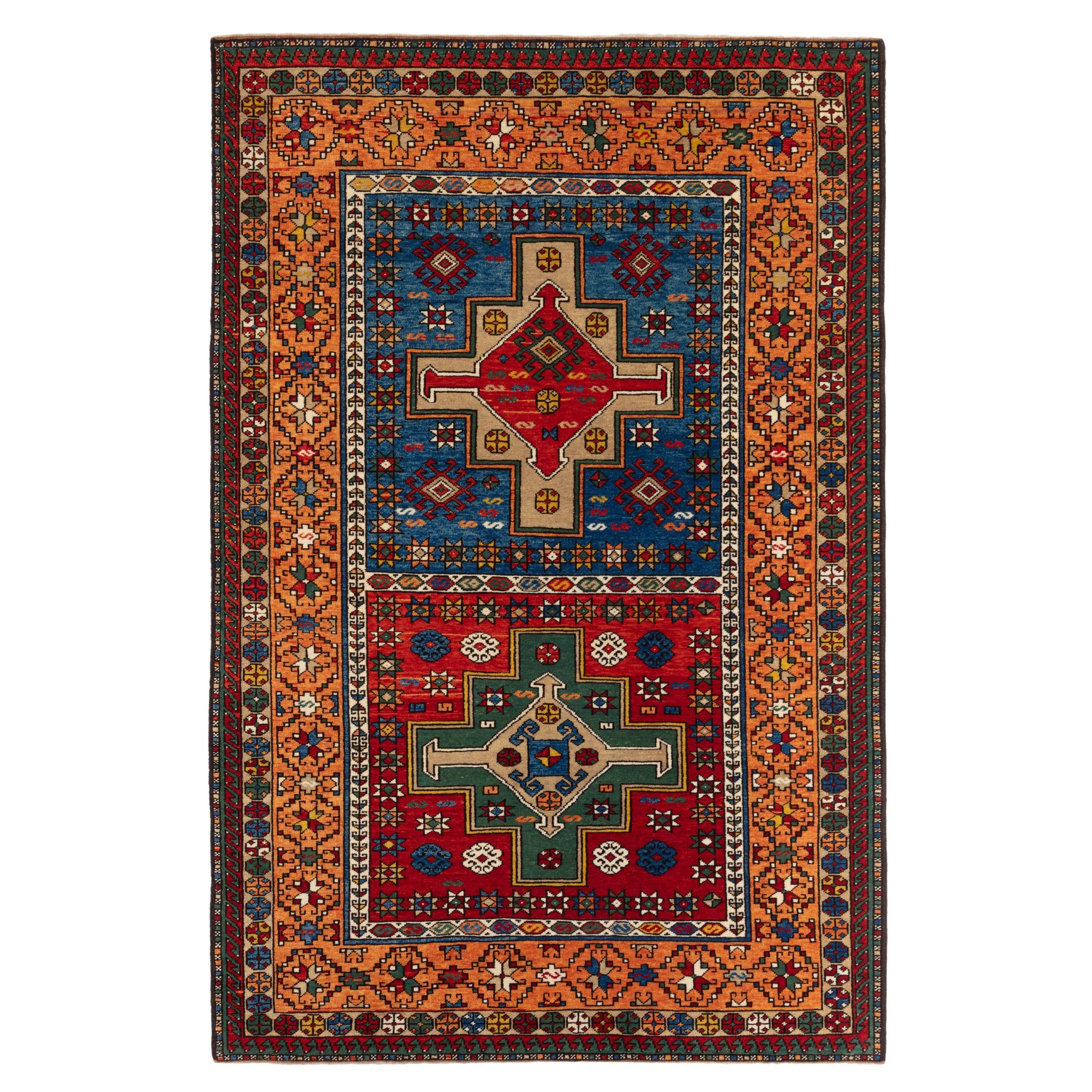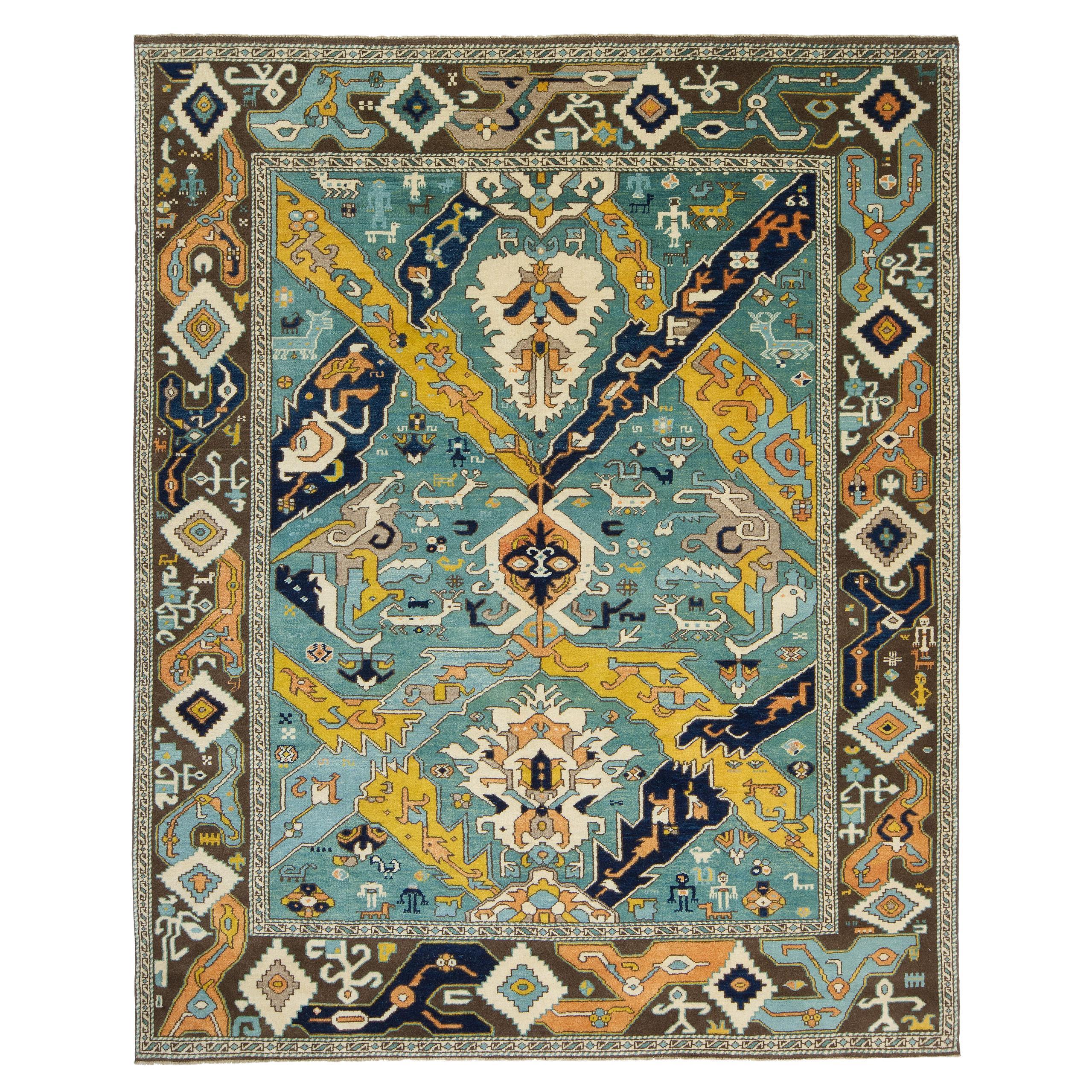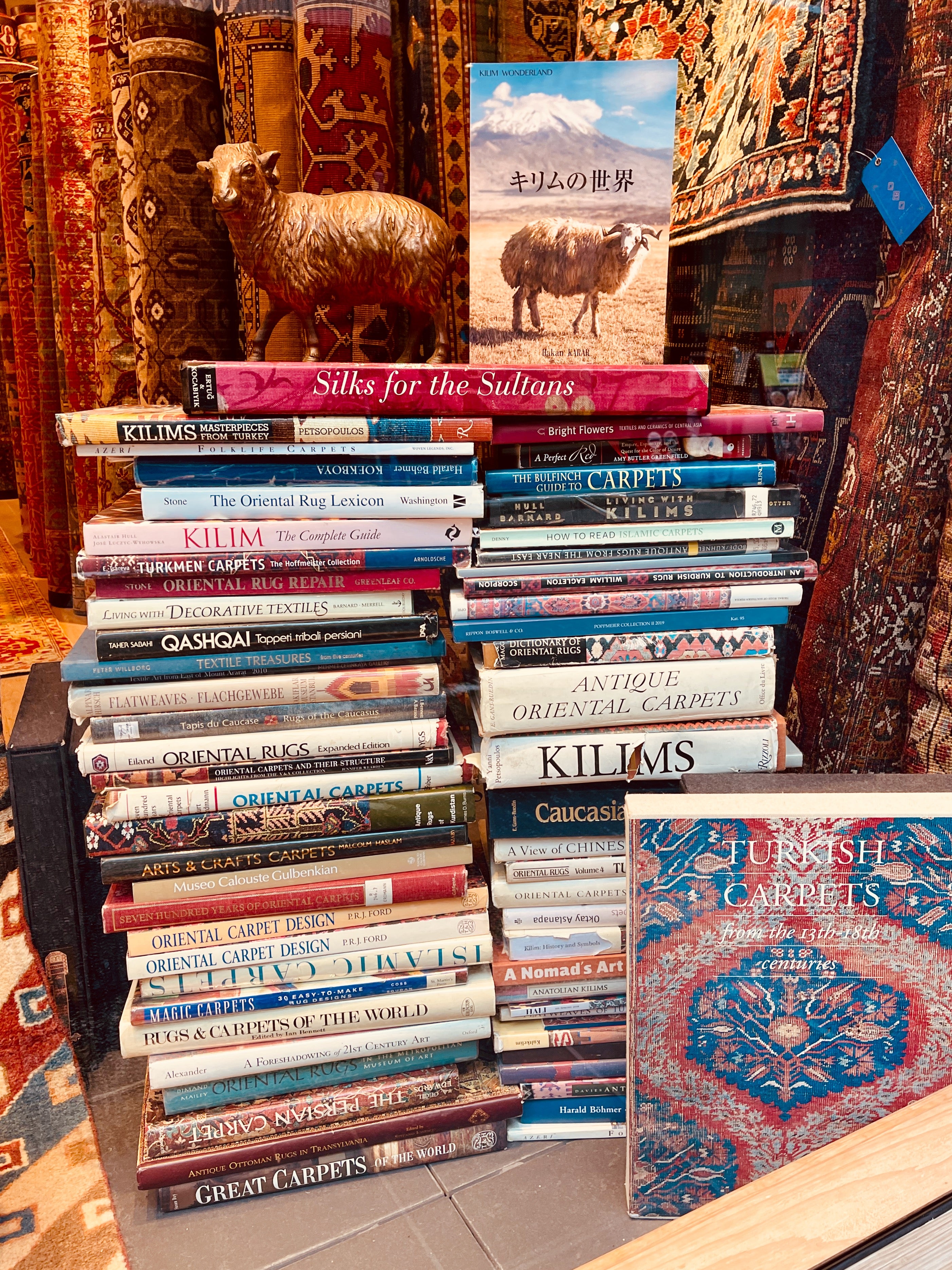Items Similar to Ararat Rugs Shirvan Rug with Hexagon Columns Caucasia Revival Carpet Natural Dye
Want more images or videos?
Request additional images or videos from the seller
1 of 5
Ararat Rugs Shirvan Rug with Hexagon Columns Caucasia Revival Carpet Natural Dye
About the Item
The source of the rug comes from the book Oriental Rugs Volume 1 Caucasian, Ian Bennett, Oriental Textile Press, Aberdeen 1993, nr.256. This is a hexagon columns rug from the late 19th century, Shirvan region, Caucasus area. This represents a well-known type of Shirvan carpet composition which has rows of stepped-edged and conjoined hexagonal motifs arranged in a single vertical row, with a flattened, saw-edged medallion at either end of the row; some authors have related the latter motif to ancient Egyptian and Persian Royal insignia. Some examples, such as that illustrated in Raymond Benardout’s Caucasian Rugs (p.51), large saw-edged medallions are found in a single vertical row, with small hexagons at their centers. In general, the idea was borne out by their resemblance to so-called ‘Zejwa’ rugs from the area south of Kuba. As with all generalizations about Caucasian weavings, however, there are numerous exceptions-for instance the cotton-weft piece with white cotton overcast sides illustrated in Murray Eiland’s Oriental Rugs (nr.159), the two examples with similar structure in Richard Purdon’s Shirvan and related Weavings from the North Caucasus (nr. 2 and 3), and the cotton-weft rug with blue cotton overcasting illustrated in Peter Bausback’s 1976 catalog (p.89). These rugs almost all have dark blue fields with myriad filler ornaments including animals, birds, and human figures; a yellow-ground border with linked ‘S’ motifs is a commonly found-a border which, both in color and design, is also found in north Persian tribal and village rugs (cf. Jenny Housego, Tribal Rugs, pl. 82). The first is illustrated in the Australian Society for Antique Rugs’ 1974 catalog, Antique Rugs from the Caucasus (no. 13), with the date read as 1902, although I prefer the reading 1304 A.H. (A.D. 1886/7). The second dated example of this type came to light recently in a provincial auction in England (Elliott and Green, Lymington, 28 June 1979, lot 363); this had the specific field and ‘interlock’ border composition, also similar to our 261, was dated 1333 A.H. (A.D. 1914) and was of very good quality apart from the albeit sparing use of synthetic orange and pink. The present rug is very similar to examples in the Metropolitan Museum (Dimand, no. 174) and in Schürmann’s book (no. 66). The design of the rug is interpreted by our designers, and the most appropriate colors to match the original is used for this rug.
Color summary: 10 colors in total, most used 4 colors are;
Wool Color 320 (Specially Washed)
Imperial Red 415 (Madder Root)
Dark Brown 316 (No Dye – Sheep’s Own Color )
Cadet Blue 26 (Indigo – Spurge)
Group: Caucasian Rugs Family
Area: Shirvan region
Material of Pile: Natural Dyed Hand-spun Wool
Material Warp / Weft: Wool on Cotton
Structure: Symmetrical knot
Knots Density: 35x42
Production Place: Southeastern Anatolia – Diyarbakir
Stock Location: Tokyo
Size (EU): 128 X 303cm
Size (US): 4'2" X 9'11"
Area (EU): 3.9m²
Area (US): 41.7ft².
- Creator:Ararat Rugs (Manufacturer)
- Dimensions:Width: 50.4 in (128 cm)Length: 119.3 in (303 cm)
- Style:Revival (In the Style Of)
- Materials and Techniques:
- Place of Origin:
- Period:
- Date of Manufacture:2021
- Production Type:New & Custom(One of a Kind)
- Estimated Production Time:Available Now
- Condition:
- Seller Location:Tokyo, JP
- Reference Number:1stDibs: LU8206233205942
ARARAT RUGS
We know and believe that the geography we come from, our past, and our lifestyle are the most important bond between us to carry the oriental carpet art and culture to the next generations along with our core values in our ongoing growth journey.
We are aware that the way to achieve this goal and carry this priceless art and culture to the future depends on a lot of work with all our people every day while adhering to our core values.
For us, art is meaningful in the sense that it brings together various cultures around the world. It is an honor for us that oriental carpet art and culture have been instrumental in this for centuries and that we are a part of this business.
We are tirelessly keeping an eye on auction house information around the world about carpets. New York's Metropolitan, London's Victoria & Albert Museums, and other famous art museums, as well as small specialized museums that house private collections, and books about oriental carpets to collect information on outstanding carpet designs and patterns from around the world. It's our Self-improving and Self-developing culture.
As Turkish Culture of Hospitality, the Kurdish Culture of Generosity, and as Japanese Culture of Business Punctuality; are the most important values that this multicultural background has taught and bequeathed to us. It is essential and valuable for us that you feel this feeling not only by looking at our oriental carpets but from the moment you contact us.
About the Seller
5.0
Platinum Seller
These expertly vetted sellers are 1stDibs' most experienced sellers and are rated highest by our customers.
Established in 1970
1stDibs seller since 2023
18 sales on 1stDibs
Typical response time: <1 hour
- ShippingRetrieving quote...Ships From: Tokyo, Japan
- Return PolicyA return for this item may be initiated within 7 days of delivery.
More From This SellerView All
- Ararat Rugs Bidjov Kazak Rug Caucasian Antique Revival Carpet Natural DyeBy Ararat RugsLocated in Tokyo, JPThis is a Bidjov Kazak rug, designed late 19th century, is a type of handwoven rug that originated from the Caucasus region, specifically from the town of Bidjov, a few miles north o...Category
21st Century and Contemporary Turkish Revival Caucasian Rugs
MaterialsWool, Natural Fiber, Organic Material
- Ararat Rugs Two Medallions Kagizman Kazak Rug Antique Revival Carpet Natural DyeBy Ararat RugsLocated in Tokyo, JPThis is a Two Medallion Kagizman Kazak Rug, also known as Caucasian Kazak rug, is a type of handwoven rug that originated from the Kagizman region in northeastern Turkey, near the bo...Category
21st Century and Contemporary Turkish Revival Caucasian Rugs
MaterialsWool, Natural Fiber, Organic Material
- Ararat Rugs Dragon Rug, Antique Caucasus Museum Revival Carpet, Natural DyedBy Ararat RugsLocated in Tokyo, JPThe source of the rug comes from the book Caucasian Carpets, E. Gans-Reudin, Thames and Hudson, Switzerland 1986, pg.37. This luxurious and varied work is known as the Cassirer drago...Category
21st Century and Contemporary Turkish Revival Caucasian Rugs
MaterialsWool, Natural Fiber, Organic Material
- Ararat Rugs Konagkend Kuba Rug, Antique Caucasian Revival Carpet, Natural DyedBy Ararat RugsLocated in Tokyo, JPThe source of the rug comes from the book Oriental Rugs Volume 1 Caucasian, Ian Bennett, Oriental Textile Press, Aberdeen 1993, nr.332. This is a sp...Category
21st Century and Contemporary Turkish Revival Caucasian Rugs
MaterialsWool, Natural Fiber, Organic Material
- Ararat Rugs Dragon Rug, Antique Caucasus Museum Revival Carpet, Natural DyedBy Ararat RugsLocated in Tokyo, JPThe source of the carpet comes from the book Hali Magazine 1993 Issue 67, pg.93 and Hali Magazine 1992 Issue 61, pg.61. Peter Bausback, Mannheim, described it on the occasion of his ...Category
21st Century and Contemporary Turkish Revival Caucasian Rugs
MaterialsWool, Natural Fiber, Organic Material
- Ararat Rugs Dragon Rug, Antique Caucasus Museum Revival Carpet, Natural DyedBy Ararat RugsLocated in Tokyo, JPThere has long been a fascination with the symbolism of the dragon and its depiction in carpet weavings. The design of ‘Dragon’ carpets consists of a field pattern composed of different colored overlaid lattices formed of pointed, serrated leaves creating intersecting lozenges, which alternately contain palmettes and are flanked by confronting stylized dragons, birds, or animal figures. The most archaic of the ‘Dragon’ carpets include dragon motifs with birds and running animals relatively naturalistically drawn, which stand either alone or in confronting pairs facing a tree. The Graf carpet, originally found in a Damascene mosque, now in the Islamiches Museum, Berlin, is considered to be the oldest example of this type, see Serare Yetkin, Early Caucasian Carpets in Turkey, Vol. II, London, 1978, p.8, fig.118. Yetkin defines four types of ‘Dragon’ carpet: ‘Archaic’, ‘Four-Dragon’, ‘Dragon-and-Phoenix’ and as a further combined development of the latter, the ‘Two-Dragon’ style, of which the present carpet falls into the ‘Dragon-and-Phoenix group along with other examples, some of which include two fragments, one in the Museum fur Kunst und Gerwerbe, Hamburg; another in the Christian Museum, Esztergom, Hungary, a complete carpet in the Kier collection; an incomplete example in the Textile Museum, Washington, D.C; the ‘Cassirer’ Dragon carpet in the Thyssen-Bornemisza collection, Lugano; the Ali Pasa Mosque carpet in Tokat, and a further example in the Vakiflar Hali Museum, Istanbul (S. Yetkin, op. cit. pp.16-20). It has been suggested that the earliest examples of the Caucasian ‘Dragon’ carpets...Category
21st Century and Contemporary Caucasian Revival Caucasian Rugs
MaterialsWool, Natural Fiber, Organic Material
You May Also Like
- 19th Century Antique Shirvan Caucasian Pictorial RugLocated in New York, NYAN intermediate square size antique Caucasian shirvan pictorial rug circa 1875. Measures: 4'1" x 4'9''.Category
Antique 19th Century Russian Campaign Caucasian Rugs
MaterialsWool
- Antique Karachov Kazak Carpet, Handmade Wool, Pale Blue, Rust, Ivory, GeometricLocated in Port Washington, NYKarachov Kazak: A quite famous and seldom-found design type, usually attributed to the Armenian weavers of the high Caucasus Mountains. The best of the ...Category
Antique Late 19th Century Russian Kazak Caucasian Rugs
MaterialsWool
- Antique Kazak Carpet, Handmade Wool, Rust, Ivory, Navy, Light Blue and GeometricLocated in Port Washington, NYThe Rust field scattered with minor stylized flower heads, hooked panels and minute cross-motifs around a column of ivory octagonal panels containing radiating flower heads and minut...Category
Antique Late 19th Century Russian Kazak Caucasian Rugs
MaterialsWool
- Antique Kazak Carpet, Handmade Wool, Rust, Ivory, Navy, Light Blue and GoldLocated in Port Washington, NYThe Rust field scattered with minor stylized flower heads, hooked panels and minute cross-motifs around a column of ivory octagonal panels containing radiating flower heads and minut...Category
Antique Late 19th Century Russian Kazak Caucasian Rugs
MaterialsWool
- Quirky Folk Art Tribal Camel Medallion Caucasian RugLocated in New York, NYA geometric tribal looking Caucasian rug from the second quarter of the 20th century with saffron ground, accents in light blue and a goldenrod border. The central medallion has a ca...Category
Mid-20th Century Caucasian Kazak Caucasian Rugs
MaterialsWool
- Vintage Handwoven Märta Måås-Fjetterström ‘Guldklimpen´ Rug, Sweden, 1944By Märta Måås-Fjetterström AB 1Located in Copenhagen K, DKBarbro Nilsson Sweden, Vintage ‘Guldklimpen´rug. Knotted pile. Designed in 1944. Handwoven at Märta Måås-Fjetterström AB, Båstad, Sweden. Märta Måås-Fjetterström (1873-1941), consi...Category
Vintage 1940s Swedish Caucasian Rugs
MaterialsWool






